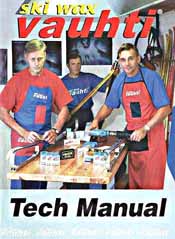Vauhti Technical Article: The Fundametals of Glide Waxing
By: Vauhti Technical Team (2003/12/12)

Waxing for racing consists of two or three applications of wax:
∑ Base waxing with conventional or LF gliders.
∑ Waxing for the current conditions with the appropriate LF or IR gliders.
∑ Top coating with fluor powders, compressed concentrates, gels or hardening powders.
Base waxing:
The purpose of base waxing is to alter the hardness of the top layer of the ski base to match the conditions and the expected abrasion from the elements. Care must be taken with base waxing especially when the base contains softer wax for storage and the conditions call for a harder base wax. In these types of situations perform the base waxing twice. The first application removes the softer wax and the second one forms the base waxing with the appropriate hardness.

Also take note of the condition of the base when performing base
waxing. Impregnated bases in good condition that have been waxed
multiple times are usually sufficient to base wax just once. If the
condition of the base is not race worthy, take special care especially
at this stage by performing the base waxing multiple times over.
Note that the thin films formed by any fluor top layer additives are not meant to take the place of proper base preparation and waxing. The purpose of the fluor additives at the final stage of waxing is to provide the finishing touch to the properly prepared ski base by providing a very thin top layer(s). The thickness of the layer is comparable to car waxing. The finished fluor layer thickness is extremely thin, about 0.010 to 0.015 mm. Take note when selecting the base wax; that the fluor top layer will make the overall waxing a bit softer.
Waxing for the conditions, the second layer
The purpose of this layer of wax is to form the best possible binding base for the fluor top layer. Depending on your desired level of waxing, choose either LF or IR fluor glide wax. Also at this stage, the key point is to choose the glide wax with the appropriate hardness. Note the wax selection criteria for this step. One fluor glider layer is sufficient, provided that the skis are well base waxed.
Top coating the final layer
The purpose of the final top coating layer is to fine tune the wax job (consisting of the base waxing and the middle layer for the current conditions) to match the conditions as best as possible.
If the conditions call for maximum durability, choose a hardening powder. In wet conditions with a lot of suction, choose an additive that best reduces the surface tension such as a fluor powder.
Note that top coating is only one aspect of a complete waxing that can not replace or fix mistakes made on the bottom layers. A thorough job on each of the layers ensures the total success of the ski preparation.
The selection of glide waxes in all layers of the waxing process is influenced by the following:
The snow and air temperature,
The relative humidity, low (below 55%), normal (55%-75%) and high (over 75%)
The structure of the snow: new or fine granule, old, coarse, icy, dirty
The distance to be skied
The technique used: free (skating) or classical (diagonal stride).
The air and snow temperatures
Air and snow temperatures influence the selection of the wax the most. Follow the snow temperature. It may be substantially lower than air temperature, especially towards the spring in sunny weather. Take note of the degree of warming by the sun.
Estimate the proportion of shady and sunny spots on the track. Select a softer waxing only if you are convinced that the warmer portions of the outing/race are more numerous than cold areas. A waxing that is too hard is always a safer choice than a too soft selection. This is most pronounced in the skating technique and especially in base waxing.
Relative humidity
Relative humidity is important criteria, especially in the selection of the type of wax to be used. In low levels of humidity (less than 50%), fluorless waxes are a competitive choice with fluor waxes. As the humidity increases to 55-60%, the advantage of fluor waxes becomes more evident. When the humidity is in excess of 75%, the importance of fluor top coat additives are extremely important. In high humidity the bases are subjected to high levels of suction and. One of Fluor's key properties of reducing friction attributable to suction is clear in these conditions.
The snow structure
The impact of snow structure is the greatest when the snow is coarse, abrasive or dirty. In all of these conditions, the base waxing of the bases must be performed with a harder wax than the conditions would normally dictate. The durability of the harder wax is better and in coarse conditions there is very little suction present. This means that the harder base waxing in these conditions does not have suction related, undesirable side effects.
In dirty snow a hard waxing does not pick up as much dirt as a softer waxing. The impact of this is emphasized as the skied distance gets longer.
In dirty snow, topcoat additives should contain fluor (either in powder, compressed block or gel form). These topcoat additives are recommended also on coarse snow when the snow is not exceedingly abrasive. In very abrasive conditions we recommend the use of hardening powders for the top layer.
The distance to be skied
The distance to be skied has a particular impact on the base waxing and the middle layer. When waxing for long distances, the base waxing needs to begin, even in warmer conditions, with the harder waxes (for example the green or Graphite Hard). The base waxing and the middle layer serve to progressively "soften" the waxing to match the conditions. The final topcoat always needs to be ironed on in one or two passes, with cold wax also rubbed on as the finishing touch.
The ski technique
For skating skis, the usual practice is almost without exception to use
a slightly harder base waxing in comparison to skis waxed for classical
diagonal stride in the same conditions. This is so because during the
glide portion, the classical ski is subjected to, at a maximum, by the
total weight of the skier. This is in contrast to the skating technique
where the ski also feels not only the weight of the skier but the force
of the skating kick. For the skating technique, the forces on the
gliding surfaces during the glide are 2 - 3 times of those in the
classical technique. A comparatively harder base waxing must be done on
a skating ski so that it will able to handle the stronger forces on the
gliding surfaces.


